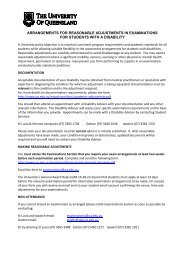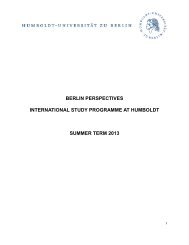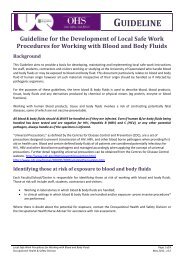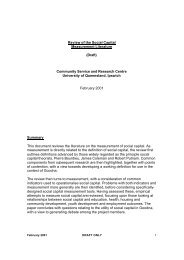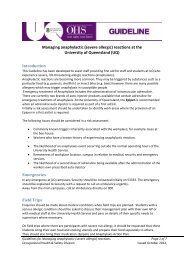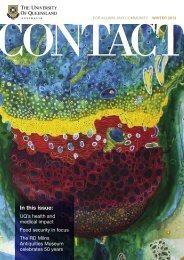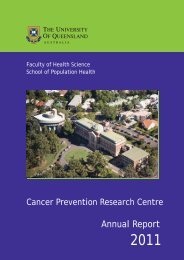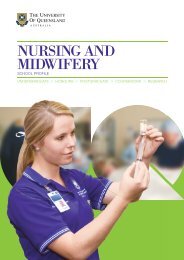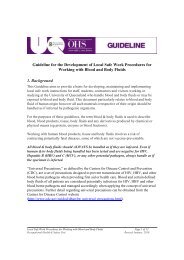Managing Traffic Incidents - University of Queensland
Managing Traffic Incidents - University of Queensland
Managing Traffic Incidents - University of Queensland
You also want an ePaper? Increase the reach of your titles
YUMPU automatically turns print PDFs into web optimized ePapers that Google loves.
(Continued from page 3)<br />
Field based traffic controllers, covering four<br />
sectors across Sydney, have been introduced<br />
by RTA NSW to take charge <strong>of</strong> on-site traffic<br />
control at incidents.<br />
Main Roads Western Australia (MRWA)<br />
has recently introduced HEROs (Highway<br />
Emergency Response Operations), based on<br />
the US Georgia Department <strong>of</strong> Transportation<br />
program which gained prominence during the<br />
1996 Atlanta Olympic Games. HEROs operate<br />
primarily on the 60 km freeway network in<br />
the Perth Metropolitan area. Currently there<br />
are three HERO units during peak periods and<br />
one <strong>of</strong>f peak, on week days. The <strong>of</strong>ficers have<br />
an innovative working arrangement where<br />
they spend 3-4 hours <strong>of</strong> their 12 hour shift on<br />
the road, followed by a period at the console<br />
in the control centre taking calls from the public,<br />
monitoring the freeway network through<br />
the SCATS traffic system and CCTVs and<br />
responding to incidents.<br />
Incident Management across Australia<br />
Their primary objective is to rapidly respond<br />
to incidents such as a stopped vehicles<br />
obstructing traffic to reduce the extent <strong>of</strong> the<br />
congestion impact, by coordinating responses<br />
from the automobile club, towing service or<br />
police to clear the blockage.<br />
An international conference on incident<br />
management Smart.<strong>Traffic</strong> was held in May<br />
2001 in Brisbane. For more information see<br />
www.transportroundtable.com.au.<br />
Links<br />
Main Roads <strong>Queensland</strong> – www.mainroads.qld.gov.au<br />
Brisbane City Council – www.brisbane.qld.gov.au<br />
<strong>University</strong> <strong>of</strong> <strong>Queensland</strong> – www.uq.edu.au/dia<br />
Roads & <strong>Traffic</strong> Authority <strong>of</strong> NSW<br />
– www.rta.nsw.gov.au<br />
VicRoads – www.vicroads.vic.gov.au<br />
Melbourne CityLink – www.transurban.com.au<br />
MI Transport Systems – www.mi-services-group.com<br />
Transport South Australia – www.transport.sa.gov.au<br />
Transport Roundtable Australasia<br />
– www.transportroundtable.com.au<br />
Main Roads Western Australia – www.mrwa.wa.gov.au<br />
Location Planning & coordination Detection Incident Management<br />
System<br />
Response<br />
Brisbane <strong>Queensland</strong><br />
– Department <strong>of</strong> Main<br />
Roads (state roads)<br />
– Cooperative Road<br />
Management Project<br />
– Operation Free Flow with<br />
Police<br />
– Public telephone calls<br />
– CCTV<br />
– Some AID (loops)<br />
– STREAMS traffic system<br />
– Primarily manual<br />
– Developing DSS system<br />
under STREAMS<br />
– Towing service by auto<br />
club (RACQ)<br />
– VMS signs<br />
Brisbane <strong>Queensland</strong><br />
– Brisbane City (local<br />
roads)<br />
– Incident Management<br />
Strategy<br />
– Public telephone calls<br />
– CCTV<br />
– BLISS traffic system<br />
– Primarily manual – <strong>Traffic</strong> Response Units<br />
(National Response)<br />
– Commercial radio<br />
Sydney NSW – Roads &<br />
<strong>Traffic</strong> Authority<br />
Melbourne Victoria<br />
– VicRoads<br />
Melbourne City Link<br />
Tollway<br />
Adelaide South<br />
Australia – Transport SA<br />
– Transport Management<br />
Centre<br />
– Network and Transport<br />
Operations business<br />
model<br />
– RTA-Police MoU<br />
– Public and agency<br />
telephone calls & radio<br />
– 400 CCTVs<br />
– AID (loops) under<br />
development<br />
– SCATS congestion alarms<br />
– Public telephone calls<br />
– CCTV<br />
– AID (loops)<br />
– Access to Police radio<br />
– Public telephone calls<br />
– CCTV<br />
– AID (video)<br />
– Mobile units<br />
– Public telephone calls<br />
– CCTV<br />
– Some AID (loops)<br />
– Developing integrated<br />
DSS<br />
– Manage planned incidents<br />
and events<br />
– Semi-automatic DSS<br />
– Manage planned incidents<br />
and events<br />
– Fully integrated DSS (MI<br />
Transport Systems)<br />
– <strong>Traffic</strong> Commanders<br />
– Towing service<br />
– <strong>Traffic</strong> Emergency Patrols<br />
– VMS, VSL and<br />
commercial radio<br />
– Incident management<br />
teams<br />
– Towing service<br />
– Incident response units<br />
(National Response)<br />
– Towing service<br />
– VMS<br />
– Manual system – Towing service<br />
– VMS<br />
Perth Western<br />
Australia – Main Roads<br />
WA<br />
– Public telephone calls<br />
– CCTV<br />
– Trialling AID (video)<br />
– Manual<br />
– Implementing integrated<br />
DSS (staged)<br />
– HERO<br />
– Towing service<br />
– VMS<br />
AID – automated incident detection CCTV – closed circuit television DSS – decision support system<br />
HERO – Highway Emergency Response Operations MOU – Memorandum <strong>of</strong> Understanding VMS – variable message signs<br />
VSL – variable speed limits<br />
4 DECEMBER 2001




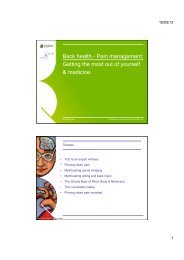
![Recycling [ PDF, 62KB ] - University of Queensland](https://img.yumpu.com/51805185/1/184x260/recycling-pdf-62kb-university-of-queensland.jpg?quality=85)
